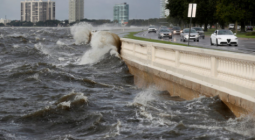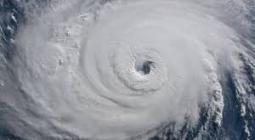Global heating makes hurricanes like Helene twice as likely, data shows
Analysis shows Gulf’s heat that worsened Helene 200-500 times more likely because of human-caused global heating
As Hurricane Milton bears down on Florida, fueled by a record-hot Gulf of Mexico, a new analysis has shown how the Gulf’s heat that worsened last month’s Hurricane Helene was 200 to 500 times more likely because of human-caused global heating.
Helene, one of the deadliest storms in US history, gathered pace over the Gulf before crashing ashore with 140mph (225km/h) winds.
The new analysis found climate change increased by 10% the amount of rainfall hurled down by the hurricane, which left more than 220 people dead across six states as it barreled north two weeks ago, flattening and drowning towns, tearing up roads and severing water supplies. It also made Helene’s winds about 13mph, or 11%, more intense.
The burning of fossil fuels has made storms as severe as Hurricane Helene about 2.5 times more likely than they were in the pre-industrial age, the multinational group of scientists at the World Weather Attribution group stated. Should the world warm by 2C above this pre-industrial period, which will occur without major cuts to emissions, storms such as Helene will get a further 10% more rainfall, the study found.
“The heat that human activities are adding to the atmosphere and oceans is like steroids for hurricanes,” said Bernadette Woods Placky, chief meteorologist at Climate Central, part of the attribution group, who added that storms like Helene and Milton were becoming “explosive” because of excess heat.
A study by Climate Central published on Monday found the sea surface temperature around Milton’s path was 400-800 times more likely because of the climate crisis.
“If humans keep heating the climate, we will keep seeing storms rapidly morph into monster hurricanes, leading to more destruction,” she said.
The speedy analysis of Helene comes before the impending landfall of Milton which also grew in strength over the Gulf of Mexico, stunning scientists by ballooning from a category 1 storm to a category 5 event, with maximum winds of 180mph, in just nine hours.
It is set to hit the Tampa area late on Wednesday, prompting dire warnings from the city’s mayor that residents will die if they don’t evacuate.
Both storms rapidly intensified over the Gulf, with researchers pointing to exceptional seawater heat as a key factor in fueling the hurricanes. Since this summer, the surface and deeper waters of the Gulf have been at record, bathtub-like temperatures, with Milton set to pass over a patch of water close to Tampa that is around 2-3C hotter than usual.
Hurricanes gain strength from hotter oceans and a warmer atmosphere, with this heat adding to the pace of the storms while also loading them with extra moisture that is then unleashed as pounding rainfall, causing the sort of catastrophic flooding that submerged communities as far inland as western North Carolina when Helene hit.
“The Gulf is still at an anomalously high temperature and when you have these warm temperatures you are more likely to get rapidly intensifying hurricanes,” said Brian McNoldy, a climate scientist at the University of Miami.
Other factors, such as countervailing wind shear that can dissipate hurricanes, are also important in storm formation but the Gulf’s lengthy fever has had experts increasingly concerned about the potential for events like Helene and Milton, McNoldy said.
“We were nervously waiting, wondering if a hurricane will take advantage of all this heat,” he said. “It’s like there was a powder keg, waiting for a spark. Now we have that spark. Milton is a remarkable storm, it’s exceptional in all history in terms of its intensification rate.”
Scientists noted that a warmer atmosphere is also able to hold more water vapor at a rate of about 7% per degree of warming. Currently, the world has warmed by at least 1.3C since the pre-industrial era and there are fears that this may be accelerating.
“What many people don’t realize is that only 1% of this extra heat is going into the atmosphere: so our records of global temperature only reflect 1% of the total increase in the earth’s heat content,” said Katharine Hayhoe, the chief scientist of the Nature Conservancy and a professor at the Texas Tech University. “Eighty-nine per cent of this heat is going into the ocean where it is contributing to rising sea levels, deadly marine heatwaves, and stronger and more rapidly intensifying hurricanes.”
Coming just a month before a US presidential election that has barely featured the climate crisis as a campaign issue, the twin hurricanes have provided US voters a stark reminder of the forces unleashed by a warming planet that can touch upon almost every aspect of life.
Donald Trump, who has called the climate crisis a “hoax” and a “scam” and has promised to slash environmental regulations for oil and gas companies in return for campaign donations, had to cancel an appearance in Miami this week because of Milton’s impact.
His opponent Kamala Harris, meanwhile, has acknowledged the dangers posed by global heating but has largely steered clear of the topic during rallies and interviews.
“Climate change is in our face right now and people are making that connection,” said Kathie Dello, the state climatologist for North Carolina, which was badly ravaged by Helene. “There’s this realization that we are seeing things we have never seen before, that we are vulnerable to climate change and we aren’t prepared for the impacts.
“Climate itself is never the No 1 election issue but the economy suffers from hurricanes, we have schools closed, people without food, shelter and water. Climate is all tied to that.”
The solution, according to the UN, is to halt the burning of fossil fuels. “Our future is in our hands,” says Hayhoe.
Cover photo: By The Guardian





